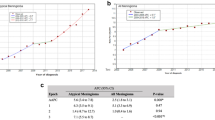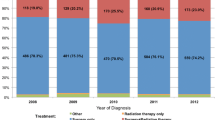Abstract
Pediatric meningiomas, which account for < 1% of all meningiomas, are thought to have unique features, including being more aggressive than their adult counterparts. The goal of this investigation was to compare pediatric and adult meningiomas in a large head-to-head comparison. We used the Surveillance, Epidemiology, and End Result (SEER) datasets to compare meningioma demographics, first treatments, and outcomes among children/adolescents (0–21 years), young adults (22–45 years), and older adults (> 45 years). During 2004–2012, SEER contained 59148 patients age 0–107 years diagnosed with meningioma, with children/adolescents accounting for 381 (0.64%) patients. Unlike older and young adults, children/adolescents with meningioma did not demonstrate female predominance, and had an equal 1:1 male-to-female ratio. Children/adolescents also had almost three-times as many spinal tumors (13.1%) than young adults (4.2%) and older adults (4.4%). Both children/adolescents and young adults had undergone more gross total resections (both 43%) versus older adults (25%), and were treated more with radiation (14.6%, and 12.0% respectively) than their older counterparts (8.5%). In addition, both children/adolescents and young adults had significantly lower all-cause mortality (4.5% in both) than older adults (24.6%), during median 35-month follow-up. Inherent limitations of the SEER datasets restrict our ability to answer important questions regarding comparisons of tumor grading, histological diagnosis, cause-specific mortality, and neurofibromatosis status. Pediatric meningiomas appear distinct from their adult counterparts as they do not display the typical female predominance and include more clinically relevant spinal tumors. More extensive surgeries, greater use of radiation therapy, and lower all-cause mortality were seen in both children/adolescents and young adults, which raises questions regarding the perceived uniquely aggressive nature of pediatric meningiomas. However, due to the significant limitations of the SEER datasets, our results must be interpreted cautiously and stand only to foster novel questions, which would be better answered in well-designed, prospective studies.


Similar content being viewed by others
References
Kotecha RS, Junckerstorff RC, Lee S, Cole CH, Gottardo NG (2011) Pediatric meningioma: current approaches and future direction. J Neurooncol 104(1):1–10. https://doi.org/10.1007/s11060-010-0503-3
Arivazhagan A, Devi BI, Kolluri SV, Abraham RG, Sampath S, Chandramouli BA (2008) Pediatric intracranial meningiomas–do they differ from their counterparts in adults? Pediatr Neurosurg 44(1):43–48
Caroli E, Russillo M, Ferrante L (2006) Intracranial meningiomas in children: report of 27 new cases and critical analysis of 440 cases reported in the literature. J Child Neurol 21(1):31–36
Drake JM, Hendrick EB, Becker LE, Chuang SH, Hoffman HJ, Humphreys RP (1985) Intracranial meningiomas in children. Pediatr Neurosci 12(3):134–139
Erdincler P, Lena G, Sarioglu AC, Kuday C, Choux M (1998) Intracranial meningiomas in children: review of 29 cases. Surg Neurol 49(2):136–140
Hui M, Uppin MS, Saradhi MV, Sahu BP, Purohit AK, Sundaram C (2015) Pediatric meningiomas an aggressive subset: a clinicopathological and immunohistochemical study. J Postgrad Med 61(1):32–35
Thuijs NB, Uitdehaag BM, Van Ouwerkerk WJ, van d V, Vandertop WP, Peerdeman SM (2012) Pediatric meningiomas in The Netherlands 1974–2010: a descriptive epidemiological case study. Childs Nerv Syst 28(7):1009–1015. https://doi.org/10.1007/s00381-012-1759-z
Menon G, Nair S, Sudhir J, Rao BR, Mathew A, Bahuleyan B (2009) Childhood and adolescent meningiomas: a report of 38 cases and review of literature. Acta Neurochir (Wien) 151(3):239–244. https://doi.org/10.1007/s00701-009-0206-8
Perry A, Giannini C, Raghavan R, Scheithauer BW, Banerjee R, Margraf L, Bowers DC, Lytle RA, Newsham IF, Gutmann DH (2001) Aggressive phenotypic and genotypic features in pediatric and NF2-associated meningiomas: a clinicopathologic study of 53 cases. J Neuropathol Exp Neurol 60(10):994–1003
Deen HG Jr, Scheithauer BW, Ebersold MJ (1982) Clinical and pathological study of meningiomas of the first two decades of life. J Neurosurg 56(3):317–322. https://doi.org/10.3171/jns.1982.56.3.0317
Kolluri VR, Reddy DR, Reddy PK, Naidu MR, Rao SB, Sumathi C (1987) Meningiomas in childhood. Childs Nerv Syst 3(5):271–273
Ferrante L, Acqui M, Artico M, Mastronardi L, Fortuna A (1989) Paediatric intracranial meningiomas. Br J Neurosurg 3(2):189–196
Baumgartner JE, Sorenson JM (1996) Meningioma in the pediatric population. J Neurooncol 29(3):223–228
Sandberg DI, Edgar MA, Resch L, Rutka JT, Becker LE, Souweidane MM (2001) MIB-1 staining index of pediatric meningiomas. Neurosurgery 48(3):590–595 (discussion 595–597)
Gao X, Zhang R, Mao Y, Wang Y (2009) Childhood and juvenile meningiomas. Childs Nerv Syst 25(12):1571–1580. https://doi.org/10.1007/s00381-009-0964-x
Greene S, Nair N, Ojemann JG, Ellenbogen RG, Avellino AM (2008) Meningiomas in children. Pediatr Neurosurg 44(1):9–13. https://doi.org/10.1159/000110656
Germano IM, Edwards MS, Davis RL, Schiffer D (1994) Intracranial meningiomas of the first two decades of life. J Neurosurg 80(3):447–453. https://doi.org/10.3171/jns.1994.80.3.0447
Rushing EJ, Bouffard JP, McCall S, Olsen C, Mena H, Sandberg GD, Thompson LD (2009) Primary extracranial meningiomas: an analysis of 146 cases. Head Neck Pathol 3(2):116–130. https://doi.org/10.1007/s12105-009-0118-1
Kotecha RS, Pascoe EM, Rushing EJ, Rorke-Adams LB, Zwerdling T, Gao X, Li X, Greene S, Amirjamshidi A, Kim SK, Lima MA, Hung PC, Lakhdar F, Mehta N, Liu Y, Devi BI, Sudhir BJ, Lund-Johansen M, Gjerris F, Cole CH, Gottardo NG (2011) Meningiomas in children and adolescents: a meta-analysis of individual patient data. Lancet Oncol 12(13):1229–1239. https://doi.org/10.1016/S1470-2045(11)70275-3
Kotecha RS, Jacoby P, Cole CH, Gottardo NG (2013) Morbidity in survivors of child and adolescent meningioma. Cancer 119(24):4350–4357. https://doi.org/10.1002/cncr.28366
Zwerdling T, Dothage J (2002) Meningiomas in children and adolescents. J Pediatr Hematol Oncol 24(3):199–204
Schut L, Canady AI, Sutton LN, Bruce DA (1994) Meningeal tumors in children 1983. Pediatr Neurosurg 20(3):207–212 (discussion 213)
Traunecker H, Mallucci C, Grundy R, Pizer B, Saran F (2008) Children’s cancer and leukaemia group (CCLG): guidelines for the management of intracranial meningioma in children and young people. Br J Neurosurg 22(1):13–25. https://doi.org/10.1080/02688690701842208
Stanuszek A, Piatek P, Kwiatkowski S, Adamek D (2014) Multiple faces of children and juvenile meningiomas: a report of single-center experience and review of literature. Clin Neurol Neurosurg 118:69–75. https://doi.org/10.1016/j.clineuro.2013.12.019
Yu JB, Gross CP, Wilson LD, Smith BD (2009) NCI SEER public-use data: applications and limitations in oncology research. Oncology (Williston Park) 23(3):288–295
List of SEER registries—About SEER (2012). http://seer.cancer.gov/registries/list.html. 2016
Cahill KS, Claus EB (2011) Treatment and survival of patients with nonmalignant intracranial meningioma: results from the Surveillance, Epidemiology, and End Results Program of the National Cancer Institute. Clinical article. J Neurosurg 115(2):259–267. https://doi.org/10.3171/2011.3.JNS101748
Dudley RW, Torok MR, Gallegos D, Liu AK, Handler MH, Hankinson TC (2015) Pediatric choroid plexus tumors: epidemiology, treatments, and outcome analysis on 202 children from the SEER database. J Neurooncol 121(1):201–207. https://doi.org/10.1007/s11060-014-1628-6
Dudley RW, Torok MR, Gallegos DR, Mulcahy-Levy JM, Hoffman LM, Liu AK, Handler MH, Hankinson TC (2015) Pediatric low-grade ganglioglioma: epidemiology, treatments, and outcome analysis on 348 children from the Surveillance, Epidemiology, and End Results database. Neurosurgery 76(3):313–319. https://doi.org/10.1227/NEU.0000000000000619
Hankinson TC, Dudley RW, Torok MR, Patibandla MR, Dorris K, Poonia S, Wilkinson CC, Bruny JL, Handler MH, Liu AK (2016) Short-term mortality following surgical procedures for the diagnosis of pediatric brain tumors: outcome analysis in 5533 children from SEER, 2004–2011. J Neurosurg Pediatr 17(3):289–297. https://doi.org/10.3171/2015.7.PEDS15224
Surveillance Research program (2016) National Cancer Institute SEER*Stat Software, version 8.1.5, 8.1.5 edn. Available at http://www.seer.canacer.gov/seerstat
Lee PA (1980) Normal ages of pubertal events among American males and females. J Adolesc Health Care 1(1):26–29
Adamo MBJC., Ruhl JL, Dickie LS (2012) 2012 SEER Program Coding and Staging Manual (NIH Publication Number 12-5581. National Institutes of Health, Bethesa, Maryland
Rushing EJ, Olsen C, Mena H, Rueda ME, Lee YS, Keating RF, Packer RJ, Santi M (2005) Central nervous system meningiomas in the first two decades of life: a clinicopathological analysis of 87 patients. J Neurosurg 103(6 Suppl):489–495. https://doi.org/10.3171/ped.2005.103.6.0489
Levy WJ Jr, Bay J, Dohn D (1982) Spinal cord meningioma. J Neurosurg 57(6):804–812. https://doi.org/10.3171/jns.1982.57.6.0804
Solero CL, Fornari M, Giombini S, Lasio G, Oliveri G, Cimino C, Pluchino F (1989) Spinal meningiomas: review of 174 operated cases. Neurosurgery 25(2):153–160
Di Rocco C, Di Rienzo A (1999) Meningiomas in childhood. Crit Rev Neurosurg 9(3):180–188
Sano K, Wakai S, Ochiai C, Takakura K (1981) Characteristics of intracranial meningiomas in childhood. Childs Brain 8(2):98–106
Doty JR, Schut L, Bruce DA, Sutton LN (1987) Intracranial meningiomas of childhood and adolescence. Prog Exp Tumor Res 30:247–254
Okechi H, Albright AL (2012) Intraventricular meningioma: case report and literature review. Pediatr Neurosurg 48(1):30–34. https://doi.org/10.1159/000341176
Simpson D (1957) The recurrence of intracranial meningiomas after surgical treatment. J Neurol Neurosurg Psychiatry 20(1):22–39
Rochat P, Johannesen HH, Gjerris F (2004) Long-term follow up of children with meningiomas in Denmark: 1935 to 1984. J Neurosurg 100(2 Suppl Pediatrics):179–182. https://doi.org/10.3171/ped.2004.100.2.0179
Terzi A, Saglam EA, Barak A, Soylemezoglu F (2008) The significance of immunohistochemical expression of Ki-67, p53, p21, and p16 in meningiomas tissue arrays. Pathol Res Pract 204(5):305–314. https://doi.org/10.1016/j.prp.2008.01.013
Ozen O, Demirhan B, Altinors N (2005) Correlation between histological grade and MIB-1 and p53 immunoreactivity in meningiomas. Clin Neuropathol 24(5):219–224
Bruna J, Brell M, Ferrer I, Gimenez-Bonafe P, Tortosa A (2007) Ki-67 proliferative index predicts clinical outcome in patients with atypical or anaplastic meningioma. Neuropathology 27(2):114–120
Alexiou GA, Mpairamidis E, Psarros A, Sfakianos G, Prodromou N (2008) Intracranial meningiomas in children: report of 8 cases. Pediatr Neurosurg 44(5):373–375. https://doi.org/10.1159/000149903
Demirtas E, Ersahin Y, Yilmaz F, Mutluer S, Veral A (2000) Intracranial meningeal tumours in childhood: a clinicopathologic study including MIB-1 immunohistochemistry. Pathol Res Pract 196(3):151–158. https://doi.org/10.1016/S0344-0338(00)80095-3
Im SH, Wang KC, Kim SK, Oh CW, Kim DG, Hong SK, Kim NR, Chi JG, Cho BK (2001) Childhood meningioma: unusual location, atypical radiological findings, and favorable treatment outcome. Childs Nerv Syst 17(11):656–662. https://doi.org/10.1007/s003810100507
Hankinson TC, Fields EC, Torok MR, Beaty BL, Handler MH, Foreman NK, O’Neill BR, Liu AK (2012) Limited utility despite accuracy of the national SEER dataset for the study of craniopharyngioma. J Neurooncol 110(2):271–278. https://doi.org/10.1007/s11060-012-0966-5
Ruggieri M, Iannetti P, Polizzi A, La Mantia I, Spalice A, Giliberto O, Platania N, Gabriele AL, Albanese V, Pavone L (2005) Earliest clinical manifestations and natural history of neurofibromatosis type 2 (NF2) in childhood: a study of 24 patients. Neuropediatrics 36(1):21–34. https://doi.org/10.1055/s-2005-837581
Wang XQ, Zeng XW, Zhang BY, Dou YF, Wu JS, Jiang CC, Zhong P, Chen H (2012) Spinal meningioma in childhood: clinical features and treatment. Childs Nerv Syst 28(1):129–136. https://doi.org/10.1007/s00381-011-1570-2
Acknowledgements
The authors would like to thank Judith Gault, PhD for her guidance and editorial assistance.
Funding
Morgan Adams Foundation (TCH); The Hartford Foundation for Public Giving (TCH); Colorado Clinical and Translational Sciences Institute/Children’s Hospital Colorado Research Institute KL2 Research Scholar Award NCATS/NIH UL1 TR001082 (TCH); NCI R03 CA212800-01 (TCH).
Author information
Authors and Affiliations
Corresponding author
Ethics declarations
Conflict of interest
The authors declare no potential conflicts of interest.
Rights and permissions
About this article
Cite this article
Dudley, R.W.R., Torok, M.R., Randall, S. et al. Pediatric versus adult meningioma: comparison of epidemiology, treatments, and outcomes using the Surveillance, Epidemiology, and End Results database. J Neurooncol 137, 621–629 (2018). https://doi.org/10.1007/s11060-018-2756-1
Received:
Accepted:
Published:
Issue Date:
DOI: https://doi.org/10.1007/s11060-018-2756-1




